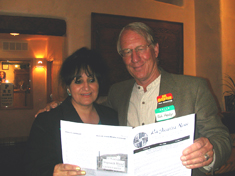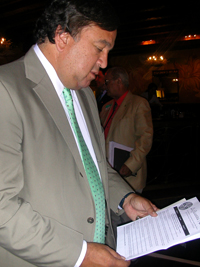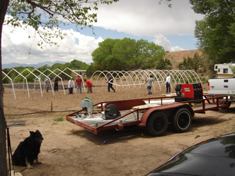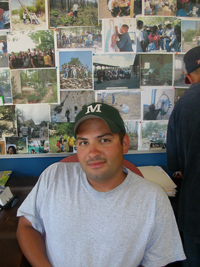 |
|
|
Volume XI |
June 2006 |
Number VI |
|
|
LANL Toxic Legacy Threatens New Mexico Water Supply By Mark SchillerWho's Reading La Jicarita News? Aamodt and Abeyta Adjudications: What Do They Mean for Top of the World Farm Water Rights? By Kay Matthews |
Chimayó Youth Conservation Corps on the Move By Kay Matthews Update on Rio Arriba Moratorium on Communication TowersOPEN LETTER TO CHIMAYÓ RESIDENTS FROM YOUR COUNCIL ON WIRELESS TECHNOLOGY |
LANL Toxic Legacy Threatens New Mexico Water SupplyBy Mark SchillerThere's a spectre haunting northern New Mexico, the spectre of Los Alamos National Laboratory (LANL). LANL is widely regarded as the world's biggest death factory, devising, constructing, and testing the weapons, nuclear and otherwise, that form the arsenal of the "big stick" behind American foreign policy. Less well publicized, however, is the legacy of toxic pollutants with which LANL has poisoned New Mexico water, air, and land in its sixty plus years of creating weapons of mass destruction. Although concerned activists, the New Mexico Environment Department (NMED), the Environmental Protection Agency (EPA) and current and former lab employees have all voiced grave concerns about how the lab uses and disposes of contaminants, the lab's policy of hiding behind "security designations" and the protection it enjoys from our congressional delegation, as the centerpiece of our economy, have historically worked to suppress information critical to exposing environmental infractions. 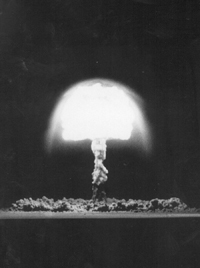 In March of 2005, however, the federal government finally acknowledged more than 1,400 sites on LANL property that required clean up because of groundwater contaminants, toxins, explosives, nitrate, and perchlorate. As a consequence, LANL signed a consent agreement with the NMED for "fence to fence" cleanup of LANL by 2015. Not surprisingly, given its past record, the DOE has already reneged on that agreement by requesting 90 million dollars less than the proposed cleanup agreement outlines for fiscal year 2007. With a total operating budget in excess of two billion dollars, LANL clearly can't blame budgetary restrictions for this shortfall. Both Senators Domenici and Bingaman believe this will result in missed cleanup deadlines and violations that could result in fines totaling millions of dollars. Now an ad-hoc coalition of groups, calling itself LANL Water Watch, has filed a "Notice of Intent to Sue" the DOE and the Regents of the University of California, which oversee LANL, for violations of the Clean Water Act. The coalition consists of community and environmental groups including: Amigos Bravos, Concerned Citizens for Nuclear Safety, Embudo Valley Environmental Monitoring Group, Partnership for Earth Spirituality, Rio Grande Restoration, and Tewa Women United. Citing reports and studies done by the NMED, EPA, and LANL itself, the notice of intent asserts that the Rio Grande and tributaries that flow through LANL property as well as groundwater from area wells are being threatened by contaminants from the lab. The coalition's press release states that "many tributary streams to the Rio Grande, either wholly or partially on LANL property . . . are designated as polluted by the NMED. Most of the streams are polluted with PCBs, gross alpha, and selenium." Some of the canyons running through LANL have also tested positive for mercury, perchlorate, and chromium. By contrast, the coalition notes that "the Rito Frijoles and Capulin Creek, both tributaries to the Rio Grande from the Pajarito Plateau not on LANL property, are not polluted" by these agents. The proposed lawsuit asserts there are 1,405 active sites on LANL "from which pollutants are or may be discharged. These sites typically include old material and liquid disposal areas, hazardous waste landfills, old dilapidated structures, contamination areas, dumping grounds, explosive testing sites, storm drains, firing ranges, septic systems and seepage pits. Following rain or snow melting events contaminants from these sites can, and have, run off into the soils, surface water and shallow groundwater of LANL's seven watersheds and canyons eventually traveling down-gradient to the Rio Grande." The discharge from these sites is currently regulated under a National Pollution Discharge Elimination System (NPDES) permit for multi-sector general use. However, the EPA has conceded that "the existing [permit] does not address all of the [sites], their specific pollutants, and the parameters to be monitored because of LANL's unique circumstances." As a consequence, the EPA and LANL have agreed "to establish a program and schedule of compliance for regulation of . . . discharges from all sites . . . until EPA issues an individual NPDES permit to regulate those discharges." Until such a permit is issued and LANL actually meets the standards set by that permit, (which it clearly is going to do everything in its power to avoid), it is operating in violation of the Clean Water Act. The coalition's lawyer, Matthew Bishop of the Western Environmental Law Center, says "the impending lawsuit is based on four specific violations of the Clean Water Act: failure to conduct adequate monitoring; failure to report violations; failure to have pollution controls in place; and making unauthorized discharges. The result of these failures is that toxic contaminants are migrating to the Rio Grande, the future source of drinking water for Albuquerque and Santa Fe." The coalition also notes that this contamination will affect food irrigated with the water, as well as fish and other wildlife that are dependent on it. According to the coalition's press packet, the most pervasive contaminates are PCBs (Polychlorinated Biphenyls) and gross alpha. PCBs are a group of industrial chemicals used in electrical equipment. The manufacture of PCBs was banned in 1977 because they were proven to accumulate in the environment and cause adverse health effects including cancer, thyroid, stomach and liver damage, and impaired reproductive and immune systems. PCBs have been detected in LANL streams at levels that far exceed New Mexico water quality standards. Gross alpha is defined by a 2004 LANL report as "The total amount of measured alpha activity without identification of specific radionuclides." The same report defines alpha particle as "A positively charged particle . . . emitted during decay of certain radioactive atoms." Plutonium-239, the principle ingredient in nuclear warheads, is the "most hazardous alpha emitter . . . highly carcinogenic, chemically reactive and flammable." Other contaminants detected in water drawn from LANL streams and test wells are known to cause thyroid damage, birth defects, cancer, gastrointestinal problems, respiratory problems, kidney and liver damage, as well as circulatory and nerve problems. Many of these contaminants have already been detected in the municipal wells that supply Los Alamos and White Rock. LANL Water Watch says that the purpose of the proposed suit is five fold: 1) Make LANL clean up all 1,405 contaminated sites; 2) Eliminate all contaminants currently discharged from LANL and prevent discharge of contaminants in the future; 3) Make LANL monitor and implement a Best Management Practices plan for discharges and dumping; 4) Make federal and state regulators hold LANL accountable; 5) Make LANL pay fines for all prior and on-going violations (which could total more than a billion dollars) and apply that money to an independent monitoring and remediation program of the sites in question. Amigos Bravos director Brian Shields underscored the importance of the proposed lawsuit in a recent op-ed piece stating, "LANL boasts a 2.2 billion dollar budget and a secure position as the darling of our Congressional delegation. LANL provides jobs. Our congressional delegates manage to procure almost as much money (4.11 billion dollars) for the Department of Energy's New Mexico facilities - which include LANL, Sandia National Laboratory, and the Waste Isolation Pilot Project - [as] the State of New Mexico's entire operating budget (4.8 billion dollars). Moreover, with the highest concentration of PhDs and millionaires in the entire country, along with a small army of lawyers, LANL can throw its weight around and successfully squelch any effort by effected communities to hold it accountable for the threat it presently poses to New Mexico's future water supply." For more information or to become involved in this battle, readers can contact Amigos Bravos at 505-758-3874, amigosbravos.org; Concerned Citizens for Nuclear Safety at 505-986-1973, nuclearactive.org; or Embudo Valley Environmental Monitoring Group at serit@cybermesa.com. ANNOUNCEMENTS• The State of New Mexico has been declared a disaster area due to drought and wind storms. Small businesses in all counties throughout New Mexico are eligible for federal assistance. Farmers and ranchers are eligible for assistance from the U.S. Department of Agriculture. All other businesses are eligible for assistance from the U.S. Small Business Administration Economic Injury Disaster Loan Program. The low interest loans are available to help small businesses offset economic losses. The business must be unable to obtain credit elsewhere. Loans are a maximum of $1.5 million at an interest rate of 4% for up to 30 years. Loans provide operating capital until the business is able to recover. The application deadline is January 18, 2007. Go to www.sba.gov/disaster for additional information.
|
Chimayó Youth Conservation Corps on the MoveBy Kay MatthewsThe Chimayó Youth Conservation Corps (CYCC) teenagers and young adults arrive each day at the former apple shed building, now CYCC headquarters, for education and training, but their presence in the community as a work force is vast and varied: restoring acequias and historic pasture land; refurbishing and landscaping senior centers and headstarts; building trails; and bringing firewood to ancianos. Now in its fifth year, the year-round program trains Junior Corps kids from ages 10 to 13, then graduates them into the Senior Corps at 14 until they reach 25. I stopped by to visit the program during an orientation session in June and met the youth and staff as they prepared for their summer projects. They took me out to the Abuelos Field, a long-term economic development project under the guidance of New Mexico State Agricultural Science Center in Alcalde. The enterprise is a perennial organic farm for wholesale growers: there are three kinds of berries - raspberry, strawberry, and blackberry; medicinal herbs (which will go to the Piñon Hills recovery program), and spring mix inside four hoop houses, grown all year long. The field is watered by a drip system pumped from a well, and in the future, the acequia. The Abuelos Field is part of the CYCC Agrarian Initiative, which has thus far planted six fields and provided the labor force for the Chimayó Chile Project, developed to maintain the traditionally grown Chimayó chile and protect it by trademark. Santa Cruz farmer Don Bustos is their "go to guy" for help and consultation.
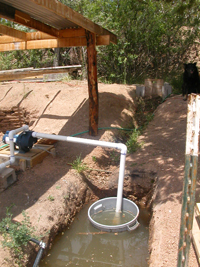
Pumping water for drip irrigation system Other summer projects include the continuing acequia and ecological restoration work at El Potrero, a 44-acre tract of Santa Fe County Open Space; renovation and landscaping at the Benny Chavez Senior Center and Chimayó Headstart; the continuation of trail construction and repair at the Cerrillos Hills Historic Park; and the ongoing Ancianos/Intergenerational Initiative that builds relationship between generations, reconnecting youth with their traditional familial and agrarian culture (Corp members provide elders with firewood, weatherize their homes, care for animals, maintain the acequias, etc.). Corps members work under the supervision of two project coordinators, Patricio Medina and Jason Casados, both of whom hail from the Las Vegas/Mora area where they worked at a youth treatment center. "We have really, really good kids in this program," Medina told me. He introduced me to Senior Corps member Jacobo Martinez, who has been involved in the program since its inception. He's demonstrated exceptional responsibility in the program and plans to attend college when he leaves. When I met CYCC executive director Suellen Strale out at Abuelos Field, she told me, "Jacobo is our number one success story." 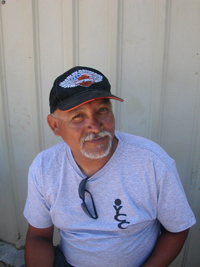
Project Coordinator Patricio Medina
Project Coordinator Jason Casados All participants in the program have an Individual Development Plan before they're employed; the staff looks at their needs and tries to set up a program to help meet those needs throughout the course of their involvement in the Corps. During the winter Corps members participate in a Harm Reduction Program where they work on communication skills, self concept, team building, problem solving, decision making, etc.; a Training Program in Career Development and Planning; and a Leadership Skills Program. Education is a huge component of CYCC and continues into their summer projects as they learn experientially from their on-the-ground work. There are also special learning sessions every week: Watershed Day, when they might spend a day on the Rio Grande learning about a riparian environment; or New Mexico History Day, when they travel to an historic site. There's also time to play: the CYCC promotional video has great footage of their rafting trip down the Rio Grande in 2005. The youth are obviously the heart of the program, but the spirit behind it and the dedication to its success comes from founder and director Suellen Stale, a longtime Chimayó resident. Strale was one of the first board members of the Chimayó Crime Prevention Organization (CCPO), incorporated in 1997 to work with law enforcement to reduce the threat of crime in Chimayó. Because of her previous experience working with youth, her interest focused on how to provide young people alternatives to drugs, gangs, and crime and she started the Chimayó Youth Conservation Corps, which became an affiliate of the CCPO in 2001. Florence Jaramillo, a board member of the CCPO, donated a portion of the apple shed to the CYCC, and one of the Corps' first projects was converting the space into offices and a meeting room (Strale told me the only power tools allowed in the process were battery powered drills). A large part of the success of the program is its collaborative efforts and diverse funding base. An initial state grant under the auspices of the Children, Youth and Families Department funded the first Harm Reduction Program, and the New Mexico Youth Conservation Corps has contributed funding to the summer programs every year. Rio Arriba County contacted the Corps during its first year and supplied a van and covered the pay roll for the conversion of the old Forest Service ranger station in Coyote to a senior center. The Truchas Land Grant paid the Corps to replant 30,000 ponderosa pines on Borrego Mesa in 2003 and 2004 after the devastating Borrego fire. The Corps' work in Cerrillos Hills Historic Park is is being done in collaboration with a park coalition, the National Park Service, and Santa Fe County Open Space, with funding from the McCune Charitable Foundation. In 2004, the CYCC received a federal grant from the Corporation for National and Community Service to underwrite its Ancianos/Intergenerational Initiative. As part of that project the Corps helped clear dead piñon trees from state land to provide firewood for the elderly, and now the Forest Service and BLM are calling the Corps to work on thinning projects. Another important partnership came together in 2005 when the Chimayó Crime Prevention Organization acquired the Chimayó Resource Compound property that was confiscated in a drug interdiction by federal agents in September 1999. CCPO governs the property in partnership with Rio Arriba County, and CYCC began restoration and environmental activity on the Compound Project in 2005. For more information about the program contact Suellen Strale or Sherrijean Serna, who runs the office and "does a little bit of everything" for the program at 351-1456. Update on Rio Arriba Moratorium on Communication TowersAs we reported in the April issue of La Jicarita News, the Rio Arriba County Commissioners imposed a nine month moratorium on the construction of communication towers in the county until a new ordinance is in place. It was then discovered that a 2000 ordinance already requires towers less than 70 feet in height go through a review process by the County Commission and actually prohibits towers above 70 feet. The T-Mobile cell phone tower that was erected in Chimayó last February should have been required to go through a review process. Instead, Rio Arriba Planning director Patricio Garcia approved its installation, without oversight. Several members of the Chimayó Council on Wireless Technology (see page 7), attended the May 27 County Commission public hearing on the moratorium to urge the commissioners to include the T-Mobile tower in the moratorium because, under the terms of the 2000 ordinance it was illegally approved, but they were unsuccessful. The Council has now filed an official complaint with the county. Planning Director Garcia is required to respond within a certain time frame or the complaint will then go before the Planning and Zoning Commission and ultimately to the County Commission. The Council is also hoping that a review of T-Mobile's application by the Department of Cultural Affairs Historic Preservation Division will reveal that the company provided false information regarding the tower's location. The tower sits rights in the middle of the historic district of Chimayó, next door to the Benny Chavez Senior Center, across the street from La Plaza del Cerro and Presbyterian Church, and just down the road from El Santuario. It also sits just feet away from the Santa Fe County line, which may reflect T-Mobile's desire to do business with Rio Arriba County rather than Santa Fe, where tower restrictions are in place. The Cultural Affairs office has also contacted the FCC, which regulates communications across the country. The Council believes the FCC is ultimately responsible for the proliferation of cell phone towers without adequate community input and restrictions. The rationale behind the FCC's reluctance to better regulate these towers is the same that it uses for power line easements and rights of way: it's "for the common good." The next battle brewing is the proliferation of Wi-Fi, which begs the question, how much does a community have to say about not only protecting its health and environment but its privacy as well. The Chimayó Council hopes that its official complaint and the Cultural Affairs review will be addressed by the end of the summer. OPEN LETTER TO CHIMAYÓ RESIDENTS FROM YOUR COUNCIL ON WIRELESS TECHNOLOGYWe, of the Chimayó Council on Wireless Technology, want to explain what we are up to. We are a group of local people who are concerned about the sudden and undemocratic invasion of health-threatening technologies into our traditional village. We are a diverse group. We are from the original Chimayó families, and we are long-time Anglo residents. We are Catholics and Protestants; teachers and county workers, psychotherapists, businesspeople, craftsmen, farmers, health aides, land grant heirs, and parents. One of us is a former Santa Fe county commissioner; one of us is a former New Mexico state historian; two of us are authors; one of us owns a religious-articles shop near the Santuario. Some of you may remember that in 2004 - through our efforts and the unprecedented support of the community - we were able to convince the Española School Board to stop in its tracks a plan to erect 11 towers on the 11 schools in the district; and because of that success, we were able to keep our children from being damaged by electromagnetic microwave radiation (EMR). Now we are faced with a T-Mobile EMR tower that was put up, without public input, in the dark of night in February. We oppose this tower because it: 1) presents a health hazard to everyone living around it; 2) is located next to the Benny Chavez Senior Center and children's playground; 3) is a desecration of a sacred site of the Tewa world, our renowned El Santuario, and La Plaza del Cerro; 4) is ugly and dominates the views of our pristine traditional valley; and 5) negatively impacts our tourist economy. Multinational corporations like T-Mobile like to insist that no studies have proven that EMR causes damage to living beings - and yet we have found that this denial is nothing more than a public relations scam. Since the 1950s, thousands of university, industry, and military studies have proven that the EMR emitted by such towers can cause cancers, leukemia, heart disorders, immunological deterioration, sleep disruptions, anxiety, seizures, etc. Studies document that communities residing near towers often demonstrate increased numbers of these illnesses, and EMR has been shown to disrupt the ability of wildlife to function and cause disease in domestic animals. We have access to these studies and are working with a researcher who has been studying the biological effects of EMR for 25 years. We are also aware that an increased number of health problems is being reported around the tower in the Fairview neighborhood of Española. Our dedication is to you, our community. We do not want your lives made difficult or cut short. We like modern conveniences - but not at the expense of our health. Our dedication is to our pilgrims, who should not have to risk illness in their pursuit of healing. Our dedication is to the beauty and wholeness of our historic community We have collected hundreds of signatures on a petition calling for the removal of the T-Mobile tower. We have convinced the Río Arriba County Commission, led by our own Elias Coríz, to stop future tower construction for nine months until regulations are crafted that adequately protect our communities. We are working with the Río Arriba Health and Human Services Department to research health effects of the towers already in existence. As always, we look to you for input - and we invite you to join us every Thursday at the John Hyson Education Center at 6 pm. Sincerely, Raymond Bal Angie López Bencomo Raymond Chávez Lucy Collier Case Crenshaw Sue Farrington Chellis Glendinning Beverly Jones Bob Jones Peter Malmgren José Alfonso Martinez Vicky Martinez Lenny Martinez Deirdre McCarthy Ron McCarthy Letty Naranjo Gina Ortiz Rose Ortiz Talissa Ralph Audrey Romero Hilario Romero Gloria Sandoval Joseph Sandoval Lorraine Sandoval Luís Sandoval Ruth Sandoval
|
Home | Current Issue | Subscribe | About Us | Environmental Justice | Links | Archive | Index
Copyright 1996-2002 La Jicarita Box 6 El Valle Route, Chamisal, New Mexico 87521.

